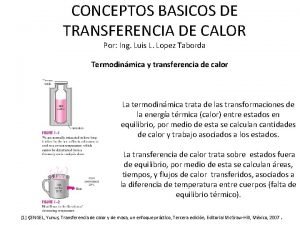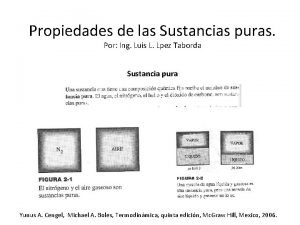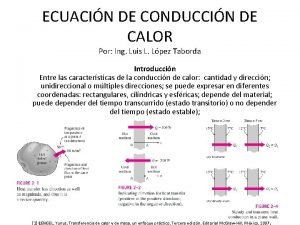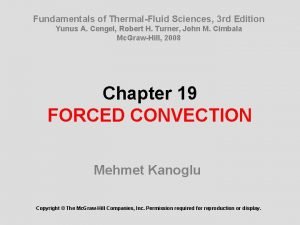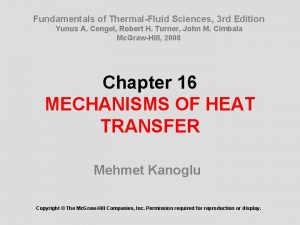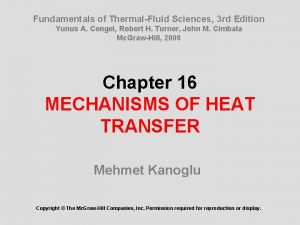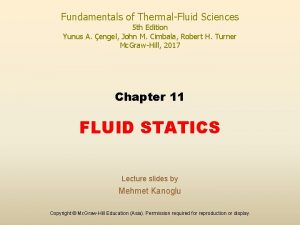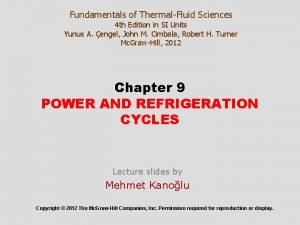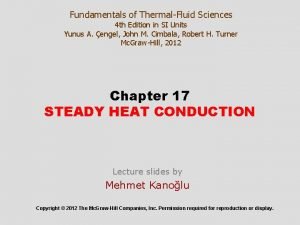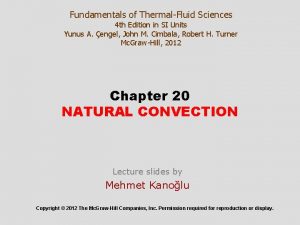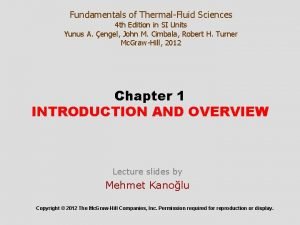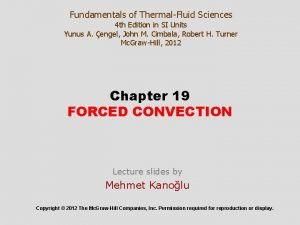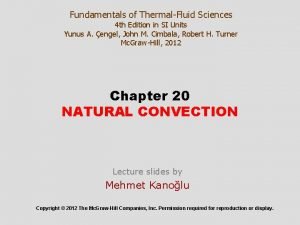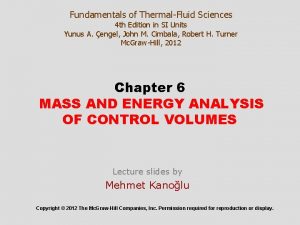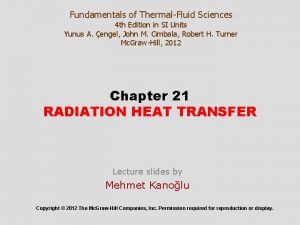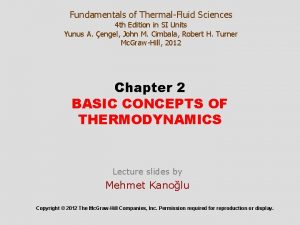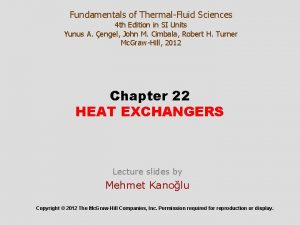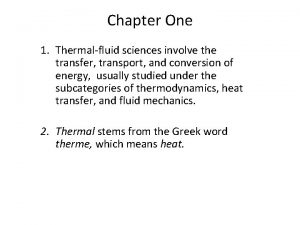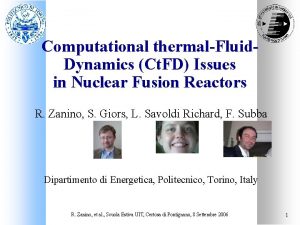Fundamentals of ThermalFluid Sciences 3 rd Edition Yunus















































- Slides: 47

Fundamentals of Thermal-Fluid Sciences, 3 rd Edition Yunus A. Cengel, Robert H. Turner, John M. Cimbala Mc. Graw-Hill, 2008 Chapter 17 STEADY HEAT CONDUCTION Mehmet Kanoglu Copyright © The Mc. Graw-Hill Companies, Inc. Permission required for reproduction or display.

Objectives • Understand the concept of thermal resistance and its limitations, and develop thermal resistance networks for practical heat conduction problems • Solve steady conduction problems that involve multilayer rectangular, cylindrical, or spherical geometries • Develop an intuitive understanding of thermal contact resistance, and circumstances under which it may be significant • Identify applications in which insulation may actually increase heat transfer • Analyze finned surfaces, and assess how efficiently and effectively fins enhance heat transfer • Solve multidimensional practical heat conduction problems using conduction shape factors. 2

STEADY HEAT CONDUCTION IN PLANE WALLS Heat transfer through the wall of a house can be modeled as steady and one-dimensional. The temperature of the wall in this case depends on one direction only (say the x-direction) and can be expressed as T(x). for steady operation In steady operation, the rate of heat transfer through the wall is constant. Heat transfer through a wall is one-dimensional when the temperature of the wall varies in one direction only. Fourier’s law of heat conduction 3

The rate of heat conduction through a plane wall is proportional to the average thermal conductivity, the wall area, and the temperature difference, but is inversely proportional to the wall thickness. Under steady conditions, the temperature distribution in a plane wall is a straight line: d. T/dx = const. Once the rate of heat conduction is available, the temperature T(x) at any location x can be determined by replacing T 2 by T, and L by x. 4

Thermal Resistance Concept Conduction resistance of the wall: Thermal resistance of the wall against heat conduction. Thermal resistance of a medium depends on the geometry and thermal properties of the medium. Electrical resistance Analogy between thermal and electrical resistance concepts. rate of heat transfer electric current thermal resistance electrical resistance temperature difference voltage difference 5

Newton’s law of cooling Convection resistance of the surface: Thermal resistance of the surface against heat convection. Schematic for convection resistance at a surface. When the convection heat transfer coefficient is very large (h → ), the convection resistance becomes zero and Ts T. That is, the surface offers no resistance to convection, and thus it does not slow down the heat transfer process. This situation is approached in practice at surfaces where boiling and condensation occur. 6

Radiation resistance of the surface: Thermal resistance of the surface against radiation. Radiation heat transfer coefficient Combined heat transfer coefficient Schematic for convection and radiation resistances at a surface. 7

Thermal Resistance Network The thermal resistance network for heat transfer through a plane wall subjected to convection on both sides, and the electrical analogy. 8

Temperature drop U overall heat transfer coefficient Once Q is evaluated, the surface temperature T 1 can be determined from The temperature drop across a layer is proportional to its thermal resistance. 9

Multilayer Plane Walls The thermal resistance network for heat transfer through a two-layer plane wall subjected to convection on both sides. 10

11

THERMAL CONTACT RESISTANCE Temperature distribution and heat flow lines along two solid plates pressed against each other for the case of perfect and imperfect contact. 12

• When two such surfaces are pressed against each other, the peaks form good material contact but the valleys form voids filled with air. • These numerous air gaps of varying sizes act as insulation because of the low thermal conductivity of air. • Thus, an interface offers some resistance to heat transfer, and this resistance per unit interface area is called thermal contact resistance, Rc. A typical experimental setup for the determination of thermal contact resistance 13

hc thermal contact conductance The value of thermal contact resistance depends on: • surface roughness, • material properties, • temperature and pressure at the interface • type of fluid trapped at the interface. Thermal contact resistance is significant and can even dominate the heat transfer for good heat conductors such as metals, but can be disregarded for poor heat conductors such as insulations. 14

The thermal contact resistance can be minimized by applying • a thermal grease such as silicon oil • a better conducting gas such as helium or hydrogen • a soft metallic foil such as tin, silver, copper, nickel, or aluminum Effect of metallic coatings on thermal contact conductance 15

The thermal contact conductance is highest (and thus the contact resistance is lowest) for soft metals with smooth surfaces at high pressure. 16

GENERALIZED THERMAL RESISTANCE NETWORKS Thermal resistance network for two parallel layers. 17

Two assumptions in solving complex multidimensional heat transfer problems by treating them as one-dimensional using thermal resistance network are (1) any plane wall normal to the x-axis is isothermal (i. e. , to assume the temperature to vary in the x-direction only) (2) any plane parallel to the x-axis is adiabatic (i. e. , to assume heat transfer Thermal resistance network for to occur in the x-direction only) combined series-parallel (3) Do they give the same result? arrangement. 18

HEAT CONDUCTION IN CYLINDERS AND SPHERES Heat transfer through the pipe can be modeled as steady and one-dimensional. The temperature of the pipe depends on one direction only (the radial r-direction) and can be expressed as T = T(r). The temperature is independent of the azimuthal angle or the axial distance. Heat is lost from a hot-water pipe to the air outside in the radial direction, and thus heat transfer from a long pipe is one-dimensional. This situation is approximated in practice in long cylindrical pipes and spherical containers. 19

A long cylindrical pipe (or spherical shell) with specified inner and outer surface temperatures T 1 and T 2. Conduction resistance of the cylinder layer 20

A spherical shell with specified inner and outer surface temperatures T 1 and T 2. Conduction resistance of the spherical layer 21

for a cylindrical layer for a spherical layer The thermal resistance network for a cylindrical (or spherical) shell subjected to convection from both the inner and the outer sides. 22

Multilayered Cylinders and Spheres The thermal resistance network for heat transfer through a three-layered composite cylinder subjected to convection on both sides. 23

Once heat transfer rate Q has been calculated, the interface temperature T 2 can be determined from any of the following two relations: 24

CRITICAL RADIUS OF INSULATION Adding more insulation to a wall or to the attic always decreases heat transfer since the heat transfer area is constant, and adding insulation always increases thermal resistance of the wall without increasing the convection resistance. In a a cylindrical pipe or a spherical shell, the additional insulation increases the conduction resistance of the insulation layer but decreases the convection resistance of the surface because of the increase in the outer surface area for convection. An insulated cylindrical pipe exposed to convection from the outer surface and thermal resistance network associated with it. The heat transfer from the pipe may increase or decrease, depending on which effect dominates. 25

The critical radius of insulation for a cylindrical body: The critical radius of insulation for a spherical shell: The largest value of the critical radius we are likely to encounter is We can insulate hot-water or steam pipes freely without worrying about the possibility of increasing the heat transfer by insulating the pipes. The variation of heat transfer rate with the outer radius of the insulation r 2 when r 1 < rcr. 26

HEAT TRANSFER FROM FINNED SURFACES Newton’s law of cooling: The rate of heat transfer from a surface to the surrounding medium When Ts and T are fixed, two ways to increase the rate of heat transfer are • To increase the convection heat transfer coefficient h. This may require the installation of a pump or fan, or replacing the existing one with a larger one, but this approach may or may not be practical. Besides, it may not be adequate. • To increase the surface area As by attaching to the surface extended surfaces called fins made of highly conductive materials such as aluminum. Some innovative fin designs. The thin plate fins of a car radiator greatly increase the rate of heat transfer to the air. 27

Fin Equation Volume element of a fin at location x having a length of x, cross-sectional area of Ac, and perimeter of p. Differential equation Temperature excess 28

The general solution of the differential equation Boundary condition at fin base 1 Infinitely Long Fin (Tfin tip = T ) Boundary condition at fin tip Boundary conditions at the fin base and the fin tip. The variation of temperature along the fin The steady rate of heat transfer from the entire fin 29

Under steady conditions, heat transfer from the exposed surfaces of the fin is equal to heat conduction to the fin at the base. The rate of heat transfer from the fin could also be determined by considering heat transfer from a differential volume element of the fin and integrating it over the entire surface of the fin: A long circular fin of uniform cross section and the variation of temperature along it. 30

2 Negligible Heat Loss from the Fin Tip (Adiabatic fin tip, Qfin tip = 0) Fins are not likely to be so long that their temperature approaches the surrounding temperature at the tip. A more realistic assumption is for heat transfer from the fin tip to be negligible since the surface area of the fin tip is usually a negligible fraction of the total fin area. Boundary condition at fin tip The variation of temperature along the fin Heat transfer from the entire fin 31

3 Convection (or Combined Convection and Radiation) from Fin Tip A practical way of accounting for the heat loss from the fin tip is to replace the fin length L in the relation for the insulated tip case by a corrected length defined as t the thickness of the rectangular fins D the diameter of the cylindrical fins Corrected fin length Lc is defined such that heat transfer from a fin of length Lc with insulated tip is equal to heat transfer from the actual fin of length L with 32 convection at the fin tip.

Fin Efficiency Fins enhance heat transfer from a surface by enhancing surface area. Ideal and actual temperature distribution along a fin. 33

Zero thermal resistance or infinite thermal conductivity (Tfin = Tb) 34

Efficiency of straight fins of rectangular, triangular, and parabolic profiles. 35

Efficiency of annular fins of constant thickness t. 36

37

• • • Fins with triangular and parabolic profiles contain less material and are more efficient than the ones with rectangular profiles. The fin efficiency decreases with increasing fin length. Why? How to choose fin length? Increasing the length of the fin beyond a certain value cannot be justified unless the added benefits outweigh the added cost. Fin lengths that cause the fin efficiency to drop below 60 percent usually cannot be justified economically. The efficiency of most fins used in practice is above 90 percent. 38

Fin Effectiveness The effectiveness of a fin • • • The thermal conductivity k of the fin should be as high as possible. Use aluminum, copper, iron. The ratio of the perimeter to the crosssectional area of the fin p/Ac should be as high as possible. Use slender pin fins. Low convection heat transfer coefficient h. Place fins on gas (air) side. 39

The total rate of heat transfer from a finned surface Overall effectiveness for a finned surface The overall fin effectiveness depends on the fin density (number of fins per unit length) as well as the effectiveness of the individual fins. The overall effectiveness is a better measure of the performance of a finned surface than the effectiveness of the individual fins. Various surface areas associated with a rectangular surface with 40 three fins.

Proper Length of a Fin Because of the gradual temperature drop along the fin, the region near the fin tip makes little or no contribution to heat transfer. m. L = 5 an infinitely long fin m. L = 1 offer a good compromise between heat transfer performance and the fin size. 41

• Heat sinks: Specially designed finned surfaces which are commonly used in the cooling of electronic equipment, and involve oneof-a-kind complex geometries. • The heat transfer performance of heat sinks is usually expressed in terms of their thermal resistances R. • A small value of thermal resistance indicates a small temperature drop across the heat sink, and thus a high fin efficiency. 42

HEAT TRANSFER IN COMMON CONFIGURATIONS So far, we have considered heat transfer in simple geometries such as large plane walls, long cylinders, and spheres. This is because heat transfer in such geometries can be approximated as onedimensional. But many problems encountered in practice are two- or three-dimensional and involve rather complicated geometries for which no simple solutions are available. An important class of heat transfer problems for which simple solutions are obtained encompasses those involving two surfaces maintained at constant temperatures T 1 and T 2. The steady rate of heat transfer between these two surfaces is expressed as S: conduction shape factor k: thermal conductivity of the medium between the surfaces The conduction shape factor depends on the geometry of the system only. Conduction shape factors are applicable only when heat transfer between the two surfaces is by conduction. Relationship between the conduction shape factor and thermal resistance 43

44

45

Once the value of the shape factor is known for a specific geometry, the total steady heat transfer rate can be determined from the following equation using the specified two constant temperatures of the two surfaces and thermal conductivity of the medium between them. 46

Summary • Steady Heat Conduction in Plane Walls ü Thermal Resistance Concept ü Thermal Resistance Network ü Multilayer Plane Walls • Thermal Contact Resistance • Generalized Thermal Resistance Networks • Heat Conduction in Cylinders and Spheres ü Multilayered Cylinders and Spheres • Critical Radius of Insulation • Heat Transfer from Finned Surfaces ü ü Fin Equation Fin Efficiency Fin Effectiveness Proper Length of a Fin • Heat Transfer in Common Configurations 47
 The human sciences tok
The human sciences tok The fundamentals of political science research 2nd edition
The fundamentals of political science research 2nd edition Fundamentals of information systems 9th edition
Fundamentals of information systems 9th edition Management fundamentals 8th edition
Management fundamentals 8th edition Fundamentals of organizational communication
Fundamentals of organizational communication Abnormal psychology ronald j comer 9th edition
Abnormal psychology ronald j comer 9th edition Floyd digital fundamentals 10th edition pdf
Floyd digital fundamentals 10th edition pdf Fluid mechanics fundamentals and applications 3rd edition
Fluid mechanics fundamentals and applications 3rd edition Fundamentals of corporate finance third canadian edition
Fundamentals of corporate finance third canadian edition Fundamentals of information systems 9th edition
Fundamentals of information systems 9th edition Fundamentals of organizational communication 9th edition
Fundamentals of organizational communication 9th edition Fundamentals of information systems 9th edition
Fundamentals of information systems 9th edition Electronics fundamentals a systems approach
Electronics fundamentals a systems approach Digital fundamentals by floyd 10th edition
Digital fundamentals by floyd 10th edition Fundamentals of corporate finance fifth edition
Fundamentals of corporate finance fifth edition Fundamentals of corporate finance, third canadian edition
Fundamentals of corporate finance, third canadian edition Fundamentals of information systems 9th edition
Fundamentals of information systems 9th edition Fundamentals of heat and mass transfer 4th edition
Fundamentals of heat and mass transfer 4th edition Computer security fundamentals 4th edition
Computer security fundamentals 4th edition Machining fundamentals 10th edition
Machining fundamentals 10th edition Fundamentals of corporate finance 6th edition
Fundamentals of corporate finance 6th edition Digital fundamentals by floyd 10th edition
Digital fundamentals by floyd 10th edition Yunus cengel
Yunus cengel Dr kamran yunus
Dr kamran yunus Yunus aksoy
Yunus aksoy Minhum terdapat hukum bacaan
Minhum terdapat hukum bacaan Region saturada liquido vapor
Region saturada liquido vapor Yunus emrenin hayatı slayt
Yunus emrenin hayatı slayt Umut al
Umut al Kalbim yine üzgün seni andım da derinden nazım biçimi
Kalbim yine üzgün seni andım da derinden nazım biçimi Yunus akkaya
Yunus akkaya Introduction for ramadan
Introduction for ramadan Yunus triyonggo
Yunus triyonggo Emre erkovan
Emre erkovan Disenterestedness
Disenterestedness Why was prophet yunus punished
Why was prophet yunus punished Generación del calor
Generación del calor Hazrat yunus
Hazrat yunus Yunus programlama dili
Yunus programlama dili Yunus hacettepe
Yunus hacettepe Peta konsep iman kepada rosul
Peta konsep iman kepada rosul Mis
Mis Using mis (10th edition) 10th edition
Using mis (10th edition) 10th edition Alexander g. schauss
Alexander g. schauss Oulu university of applied sciences
Oulu university of applied sciences Nerviano medical sciences
Nerviano medical sciences Focus groupe en sciences sociales
Focus groupe en sciences sociales Railroad training school
Railroad training school






















